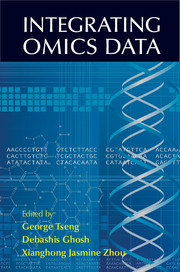Book contents
- Frontmatter
- Contents
- Contributors
- Introduction
- Part A Horizontal Meta-Analysis
- Part B Vertical Integrative Analysis (General Methods)
- Part C Vertical Integrative Analysis (Methods Specialized to Particular Data Types)
- 12 eQTL and Directed Graphical Model
- 13 MicroRNAs: Target Prediction and Involvement in Gene Regulatory Networks
- 14 Integration of Cancer Omics Data into a Whole-Cell Pathway Model for Patient-Specific Interpretation
- 15 Analyzing Combinations of Somatic Mutations in Cancer Genomes
- 16 A Mass-Action-Based Model for Gene Expression Regulation in Dynamic Systems
- 17 From Transcription Factor Binding and Histone Modification to Gene Expression: Integrative Quantitative Models
- 18 Data Integration on Noncoding RNA Studies
- 19 Drug-Pathway Association Analysis: Integration of High-Dimensional Transcriptional and Drug Sensitivity Profile
- Index
- Color plates
17 - From Transcription Factor Binding and Histone Modification to Gene Expression: Integrative Quantitative Models
from Part C - Vertical Integrative Analysis (Methods Specialized to Particular Data Types)
Published online by Cambridge University Press: 05 September 2015
- Frontmatter
- Contents
- Contributors
- Introduction
- Part A Horizontal Meta-Analysis
- Part B Vertical Integrative Analysis (General Methods)
- Part C Vertical Integrative Analysis (Methods Specialized to Particular Data Types)
- 12 eQTL and Directed Graphical Model
- 13 MicroRNAs: Target Prediction and Involvement in Gene Regulatory Networks
- 14 Integration of Cancer Omics Data into a Whole-Cell Pathway Model for Patient-Specific Interpretation
- 15 Analyzing Combinations of Somatic Mutations in Cancer Genomes
- 16 A Mass-Action-Based Model for Gene Expression Regulation in Dynamic Systems
- 17 From Transcription Factor Binding and Histone Modification to Gene Expression: Integrative Quantitative Models
- 18 Data Integration on Noncoding RNA Studies
- 19 Drug-Pathway Association Analysis: Integration of High-Dimensional Transcriptional and Drug Sensitivity Profile
- Index
- Color plates
Summary
Abstract
Gene expression is precisely regulated by transcription factors and histone modifications. Most previous studies have focused on the regulation of specific genes by TFs or histone modifications. In recent years, genome-wide TF binding and histone modification data have been produced by high-throughput sequencing-based technologies such as ChIP-seq. With these data, we are able to construct statistical models to quantify the relationship between TF binding, histone modification, and gene expression. In this chapter, we first propose a statistical framework that integrates TF binding and/or histone modification signals to predict gene expression levels. We subsequently apply it to address several biological questions with the intention of providing new insight into the regulatory mechanisms of TFs and histone modifications. We show that more than 50% of variation in gene expression levels can be explained by TF binding or histone modification signals in the promoter region of genes. The TF binding and histone modification signals are highly redundant in terms of gene expression prediction. We also demonstrate that the TF model and histone model trained on protein-coding genes can accurately predict the expression levels of noncoding genes, suggesting a similar regulatory mechanism shared between the two gene classes. Moreover, the differential expression of genes under different conditions is largely reflected by their TF binding and histone modification changes. Altogether, the predictive models suggest that TF binding and histone modifications are highly interrelated, and both are involved in gene expression regulation in a cooperative manner.
Introduction
Gene expression is under precise regulation to ensure that genes are expressed at the right time and in the right tissues. Eukaryotic gene expression at the transcriptional level is mainly regulated by transcription factors (TFs) [1, 2] and histone modifications (HMs) [3, 4]. TFs are a family of proteins that bind to specific DNA sequences to activate or repress the transcriptional initiation of genes [5]. They can also affect gene expression by recruiting chromatin modifiers to induce chromatin structure changes [6, 7]. Eukaryotic chromosomes are organized into chains of nucleosomes, which are composed of DNA wrapped around octamers of core histone proteins. Covalent modification of histone proteins can remodel local chromatin structure and thus affect the accessibility of TFs to DNA regions [1]. In addition, histone modifications can also participate in gene transcription by recruiting or interacting with transcriptional activators or repressors [3].
Information
- Type
- Chapter
- Information
- Integrating Omics Data , pp. 380 - 402Publisher: Cambridge University PressPrint publication year: 2015
Accessibility standard: Unknown
Why this information is here
This section outlines the accessibility features of this content - including support for screen readers, full keyboard navigation and high-contrast display options. This may not be relevant for you.Accessibility Information
- 1
- Cited by
